Liu Chang, Chen Qijuan, Chen Guiyue, Che Xiaoxuan
(School of Power and Mechanical Engineering, Wuhan University, Wuhan 430072)
Abstract: Establish a household photovoltaic-fuel cell hybrid power generation system, which is composed of photovoltaic power generation devices, fuel cells/supercapacitors, electrolytic cells, hydrogen storage devices, and power regulation units. Because photovoltaic power generation is affected by changes in sunlight, the use of fuel cells and super capacitors combined with photovoltaic devices to generate power can ensure the stability and reliability of the hybrid power generation system. Taking the sunshine intensity and household electricity consumption in Wuhan as an example, the system is simulated in Matlab/Simulink software, and the results show that the hybrid power generation system can meet the general household electricity demand.
0 Preface
In recent years, under the background of national encouragement policies and the vigorous development of the photovoltaic industry worldwide, solar photovoltaic power generation has been increasingly studied and applied. Especially with the gradual reduction of the cost and cost of solar panels, their application in household electrical systems has also been promoted and popularized. With the development of modern technology and social progress, people’s housing concepts and needs have undergone fundamental changes, and living conditions have become an important indicator of the quality of life of modern residents. Therefore, new housing with "high quality and low energy consumption" as the basic characteristics will be Become the future development direction of the housing industry [1]. However, the solar energy density is low, and the photovoltaic system power supply is affected by seasonal and meteorological conditions, and it is difficult for a single solar power generation to meet the load requirements of the home.
In order to meet the stable and continuous demand for household electricity, the combination of solar energy and fuel cells and the replacement of traditional battery energy storage with hydrogen production will have good development prospects. In this "photovoltaic-fuel cell (hydrogen) hybrid power generation system", in addition to providing photovoltaic power to the load, the excess electricity can be used to electrolyze water to produce hydrogen and store it; when the photovoltaic power generation system cannot meet the power supply demand, the fuel cell can be Use stored hydrogen to generate electricity. Such a hybrid power generation system can improve energy utilization efficiency, reduce fossil fuel consumption, is environmentally friendly, clean and energy-saving, and its low noise characteristics during solar and fuel cell operation ensure that the hybrid system can be installed near or in the center of the load. It will affect the normal work and rest of residents [2], and can achieve the goals of high quality, low power consumption, safety and reliability in modern homes. Based on the above analysis, this paper proposes a photovoltaic-fuel cell hybrid power generation system for home use, and establishes a simulation model of the system in Matlab/Simulink to analyze its performance.
1 Hybrid system structure and operation mode
1.1 Hybrid system structure
The structure of the photovoltaic-fuel cell hybrid power generation system proposed in this paper for home use [3] is shown in Figure 1. The system mainly includes solar cell arrays, fuel cells/super capacitors, electrolytic cells, hydrogen storage devices, and controllable Voltage type DC converter (boost converter), DC/AC inverter (IGBT) and transformer, etc.
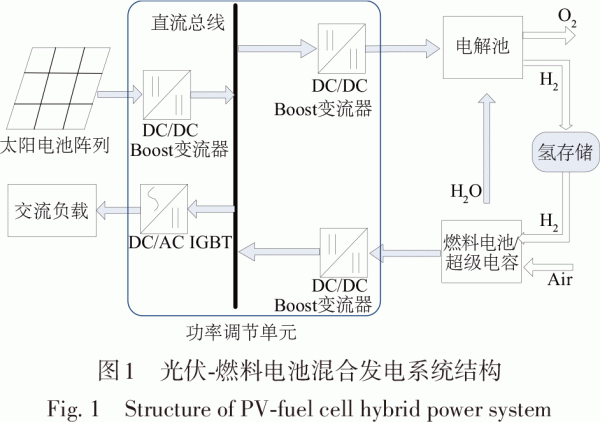
In this system, the solar cell array is the core part. It directly converts solar energy into electric energy for load use. The remaining electric energy is supplied to the electrolytic cell to electrolyze water to produce hydrogen. The generated hydrogen is stored in the hydrogen storage tank and supplied to the fuel cell.
Using fuel cells as a backup power source to replace traditional photovoltaic power generation systems using batteries to store energy and provide electrical energy has great advantages. First, the power generation efficiency of fuel cells mainly depends on the electrolyte, and the fuel is stored outside the battery, so its power generation efficiency is not It is limited by the battery capacity. Although the battery’s own power generation efficiency is high, energy loss will occur during the conversion of electrical energy, which will seriously reduce the efficiency, and the chemical energy in the battery is stored in the positive and negative electrodes of the battery, and the power generation efficiency will be affected by the battery capacity. Secondly, the fuel cell has a high power conversion efficiency at full load, even if the load is reduced, it can maintain a high efficiency conversion rate, and the battery will reduce the voltage and efficiency during discharge, which is difficult to meet the demand for residential electricity. Changes in demand; finally, fuel cells are easier to operate than batteries, and will not pollute the environment, and are more suitable as auxiliary power generation for photovoltaic power generation systems. Although the fuel cell has good power supply performance in steady-state operation, considering its relatively weak response to instantaneous and short-term peak power [4], some scholars have proposed that supercapacitors can be connected in series with them for low power requirements. After the fuel cell supplies power to the load, the surplus electric energy can be stored by the super capacitor; when high power requirements, the fuel cell generates the rated power, and at the same time, the super capacitor discharges to meet the load demand, so that the fuel cell can not increase the cost and size Get better performance on the basis of.
The power adjustment unit includes a step-up DC converter, a DC/AC inverter, etc., which is mainly responsible for adjusting the system to output ideal voltage and power for residents. Because the output current of the solar cell changes with changes in temperature and light intensity, the fuel cell's own characteristics make its output voltage uncontrollable low-voltage direct current [4], so the battery can be replaced by a DC converter or a DC/AC inverter. The output voltage is adjusted to DC or AC that meets the requirements of household power stability.
1.2 How the system works
According to various power sources, environment and residents' electricity consumption, 3 working modes can be drawn up for the system:
1) Daytime mode, that is, during the day with sufficient sunlight, solar power is sufficient to meet the electricity demand of residents, and the excess power is supplied to the electrolytic cell to electrolyze water to produce hydrogen and store it for use by the fuel cell;
2) Night mode, that is, during the day and night with insufficient light, when solar power is insufficient, the fuel cell cooperates with photovoltaic power generation to provide power to the load;
3) Continuous rainy weather mode, that is, when the system cannot meet the demand of household electricity in continuous rainy weather, it can be powered by the grid.
2 Calculation of system power generation and load
2.1 Capacity design of photovoltaic power generation system
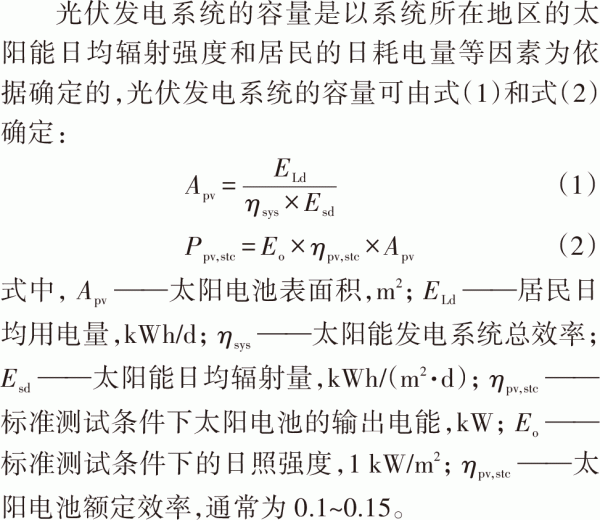
2.2 Capacity design of fuel cell and electrolyzer
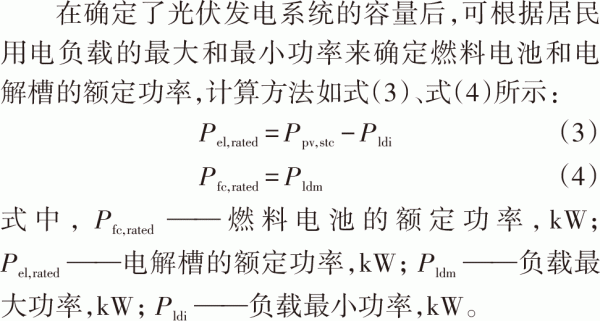
3 system modeling
3.1 Photovoltaic array model
The equivalent circuit of the solar cell is shown as in Fig. 2.
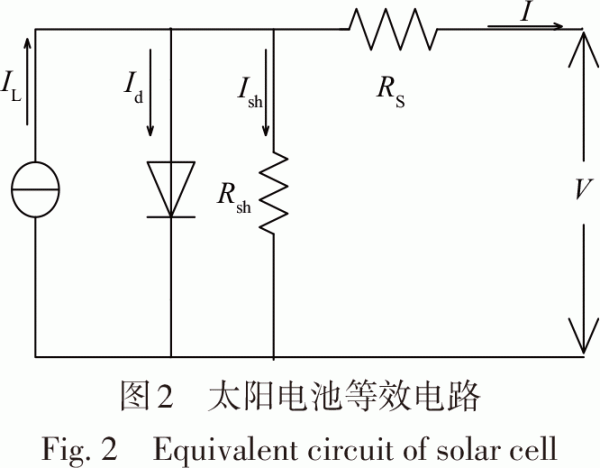
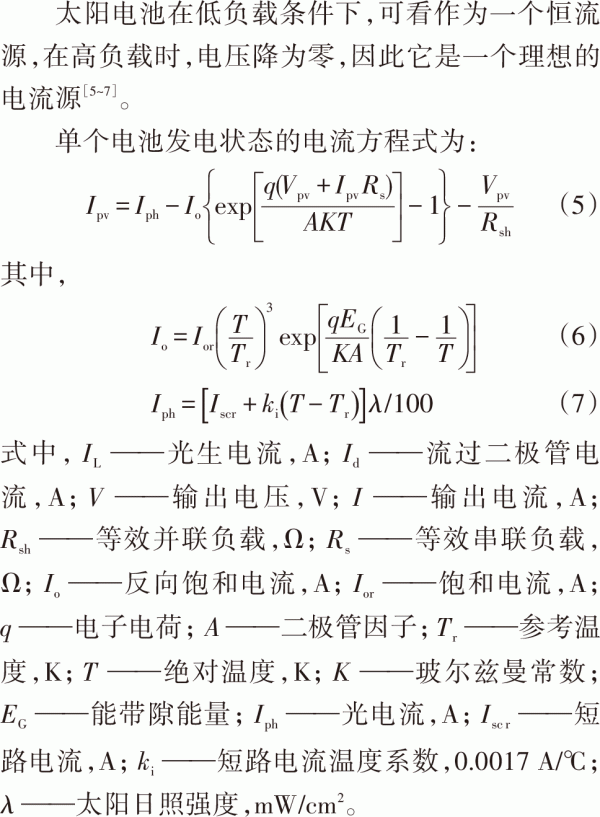
The solar cell can be regarded as a constant current source under low load conditions. Under high load, the voltage drops to zero, so it is an ideal current source [5~7].
3.2 Fuel cell model
The basic principle of the proton exchange membrane fuel cell (PEMFC) is that hydrogen and oxygen react to produce water and release electricity [8-13]. The working principle of a single proton exchange membrane fuel cell is shown in Figure 3.
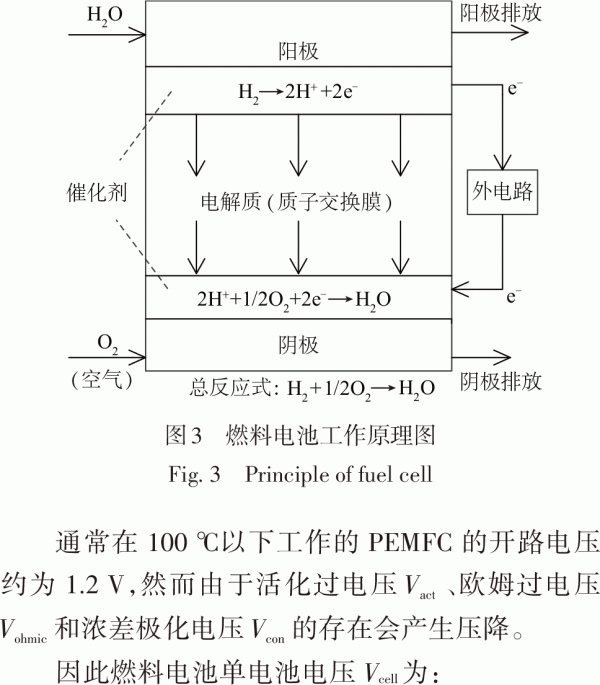
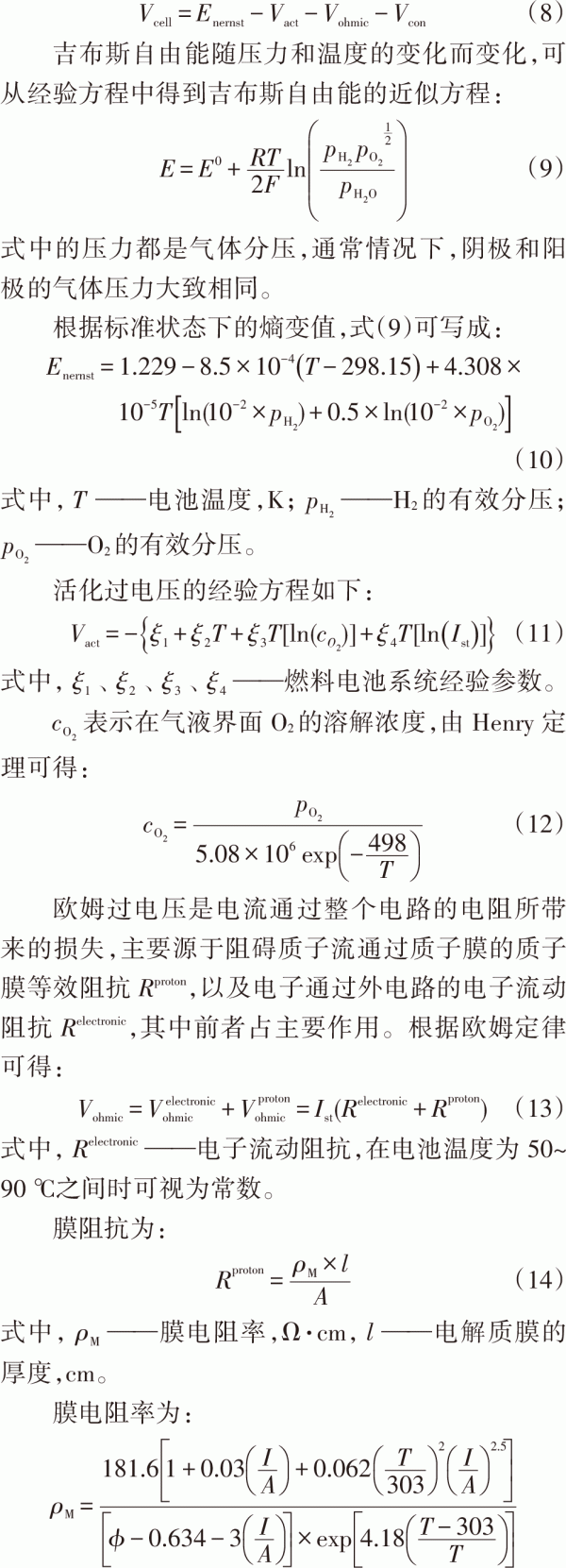

4 System simulation and result analysis
In order to test the feasibility of the hybrid power generation system proposed in this paper, a Simulink simulation model of the hybrid system was established in Matlab software [7], including photovoltaic power generation system model, fuel cell/supercapacitor model, electrolytic cell model, DC boost transformer The inverter model [14, 15] and the inverter model [16, 17] are shown in Figure 4.
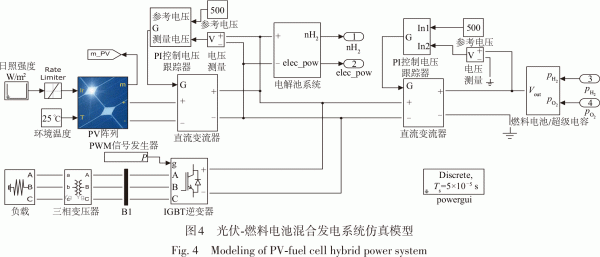
4.1 Determination of the capacity of the hybrid power generation system
Take Wuhan City as an example. According to laboratory measurement data, in October each year, its daily average radiant energy is 4.9kWh/(m2·d), and the average daily power consumption of residents is 7.8kWh/d. Take the total efficiency of the photovoltaic power generation system ηsys is 4.2%, the rated efficiency of the solar cell is ηpv, and the stc is 13.8% [18]. According to equations (1) and (2), the surface area of ​​the solar cell is 37.9m2, and the peak power of the solar cell is about 5.23kW. Assuming that the peak power and trough power of the load are 3.0 and 0.5kW, respectively, according to equations (3) and (4), the rated power of the fuel cell is 3kW and the rated power of the electrolytic cell is 4.73kW.
4.2 Analysis of system simulation results
The sunlight intensity collected by the Solar Energy Laboratory of Wuhan University on a certain day in October 2015 is shown in Figure 5a, the ambient temperature is set to 25°C, and the user's power load waveform is shown in Figure 5b. Under changing light intensity, the volt-ampere characteristics of solar cells change accordingly, so the output power of the photovoltaic system also changes. Because the load power is also variable, when the output power of the photovoltaic system can meet the requirements of household electricity, the photovoltaic system alone supplies power to the load, and the remaining power is supplied to the electrolytic cell to electrolyze water to produce hydrogen and store it for use by the fuel cell; When the output power cannot meet the household electricity requirements, the fuel cell works according to the difference between the load power and the output power of the photovoltaic system.
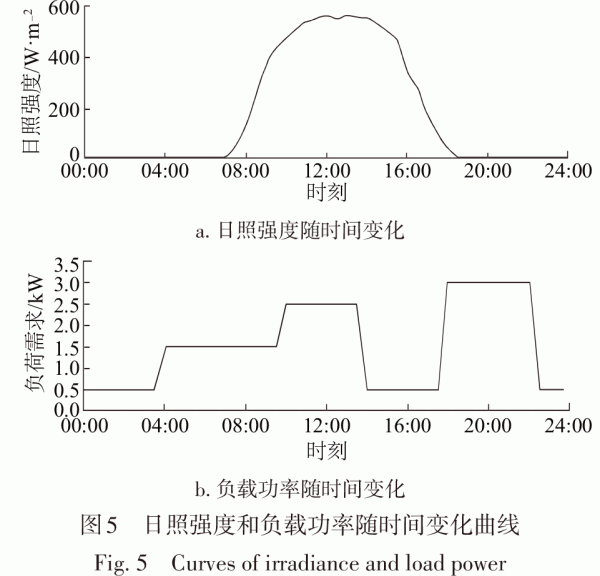
The system is simulated under the conditions mentioned above, and the simulation results are shown in Figure 6 to Figure 8.
Figure 6 is a graph showing the changes in the output power, voltage and current of the solar cell array over time. Comparing Figure 6a with Figure 5a, it can be seen that the output power of the photovoltaic system is consistent with the sunshine intensity.
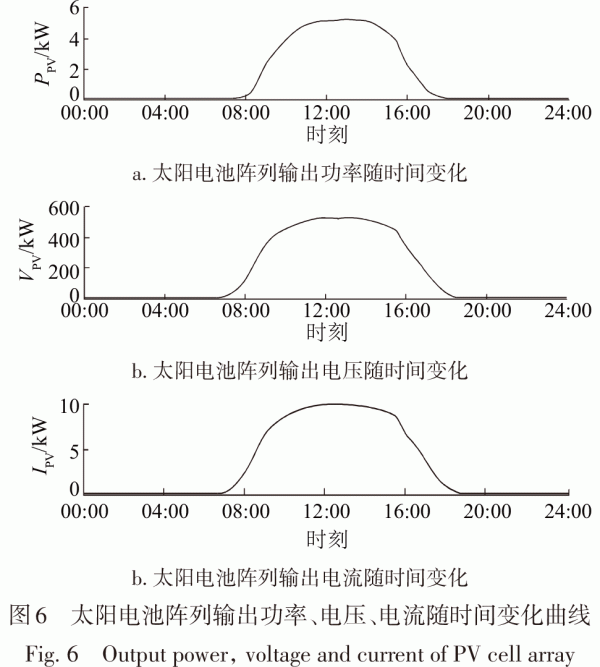
Fig. 7 is a graph showing changes in fuel cell output power, voltage and current over time. It can be seen from Figure 7a that the output power of the fuel cell is almost zero between 08:30 and 17:00. This is because the electric energy output by the photovoltaic power generation system during this time period can basically meet the electricity demand of users. From the comparison of Figure 7a with Figure 5a and Figure 6a, it can be seen that from 00:00 to 6:00 and 18:30 to 24:00, the sunshine intensity is zero, and the power output of the photovoltaic power generation system is zero. It is completely provided by the fuel cell.
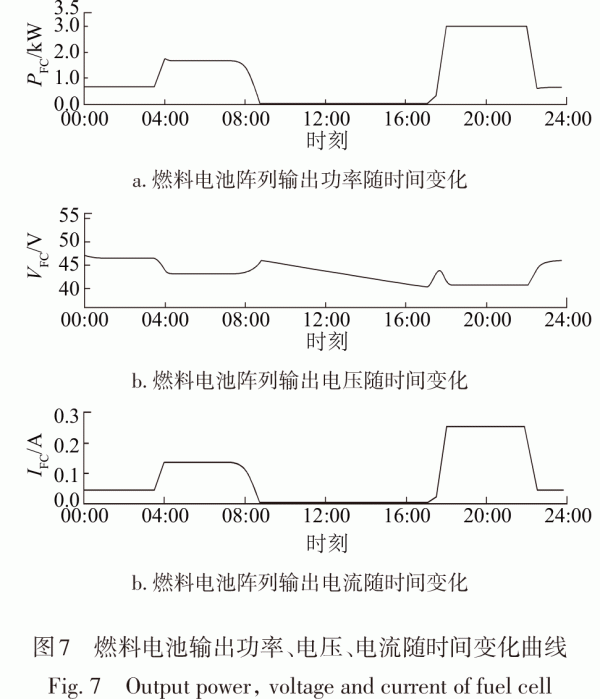
The response curve of the total output power of the photovoltaic-fuel cell hybrid power generation system to user load changes is shown in Figure 8. It can be seen from the figure that the power supply of the hybrid power generation system is basically consistent with the user's power load demand. When the solar battery output power cannot meet the load demand, the fuel cell can be better supplemented to assist the solar battery power supply, so that the system can meet the residents' daily electricity demand as a whole, and realize the effective tracking of the load.
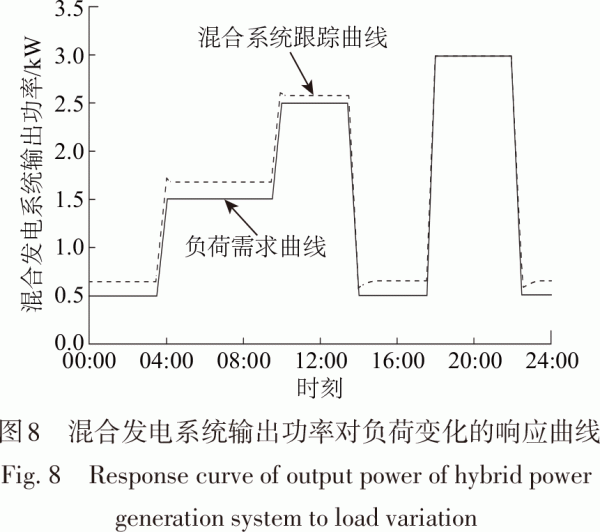
5 System economic feasibility analysis
At this stage, my country's photovoltaic power generation technology is relatively mature, and it is widely used in homes and residents. According to the reference [19], the investment cost of 1kW fuel cell is about 45258.4Â¥, and the cost of 1kW ordinary storage battery is about 15200Â¥. This shows that the investment cost of fuel cells is still relatively high.
From the above analysis, it can be seen that the application of photovoltaic-fuel cell hybrid power generation systems to homes at this stage still has a high cost. However, with the improvement of photovoltaic power generation and hydrogen production efficiency by electrolysis of water and the reduction of the cost of proton exchange membrane fuel cells, photovoltaic- The economic and social benefits of fuel cell hybrid power generation systems will become increasingly significant. And because the system has the characteristics of high energy storage density, long service life, and pollution-free, it can be applied to some special applications, such as making military special power sources or used in military communication systems; fuel cells generate electricity while also producing Pure water, therefore, the system is also suitable for islands lacking fresh water.
6 Conclusion
This paper establishes a dynamic model of a photovoltaic-fuel cell hybrid power generation system for homes, including photovoltaic power generation system models, fuel cell/supercapacitor models, electrolytic cell models, DC boost converter models, and inverter models, etc. Matlab/Simulink software simulates and analyzes the model of the hybrid power generation system based on the actual electricity consumption of the home. The simulation results show that the use of fuel cells in the hybrid power generation system can better overcome the adverse effects of the randomness of photovoltaic power generation on the power generation system. The hybrid system guarantees a good power supply when the intensity of sunlight and residential electricity load changes, and it has power supply reliability and stability. Finally, taking the photovoltaic sunshine intensity and residential electricity consumption in Wuhan as an example, it is verified that the hybrid power generation system can meet the household electricity load requirements.
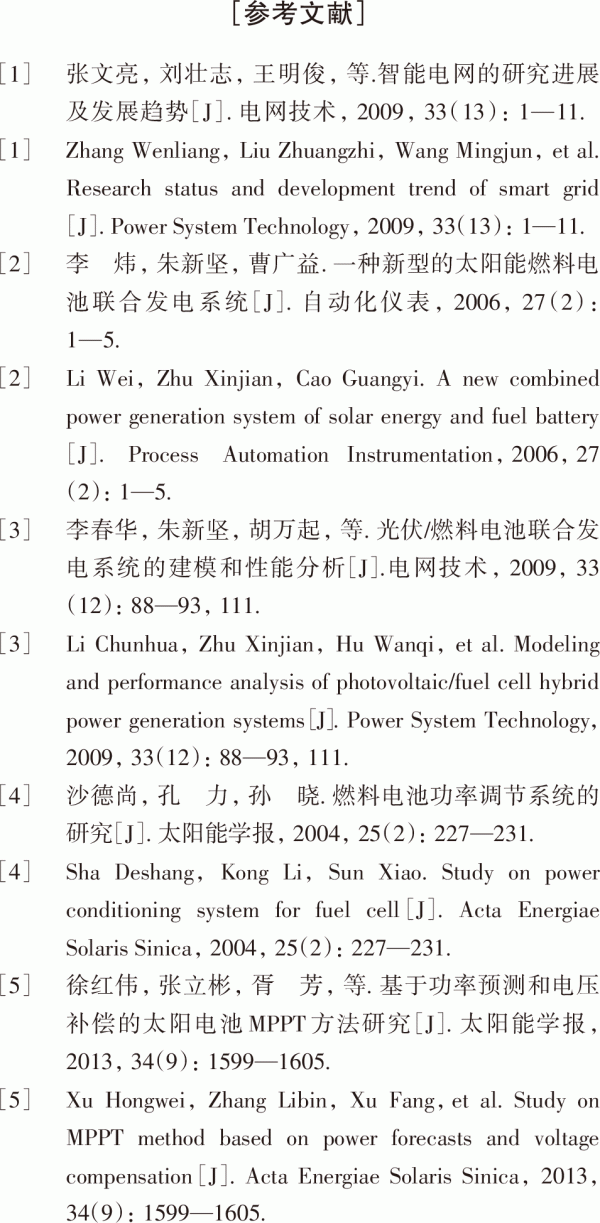
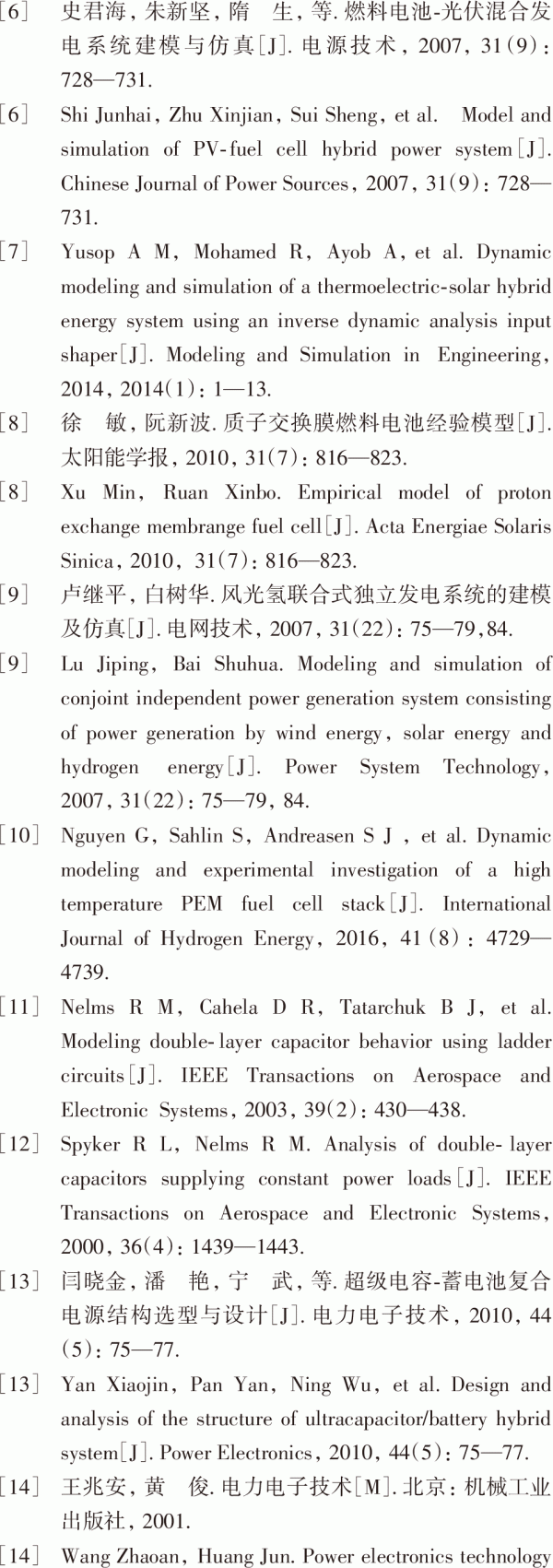
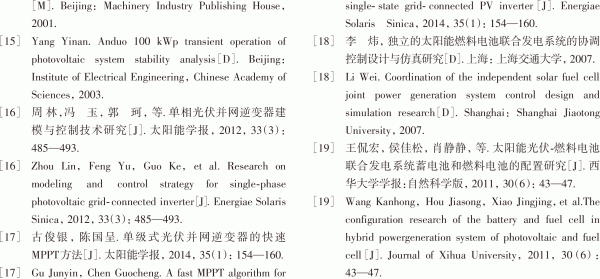
We are professional manufacturer of Infrared Thermometer. We focused on international export product development, production and sales. We have improved quality control processes of Infrared Thermometer to ensure each export qualified product.
If you want to know more about the Infrared Thermometer, please click the product details to view parameters, models, pictures, prices and Other information about Infrared Thermometer.
Whatever you are a group or individual, we will do our best to provide you with accurate and comprehensive message about Infrared Thermometer!
Infrared Thermometer
Infrared Thermometer,Laser Thermometer Guns,Safe Infrared Thermometer,High Temperature Infrared Thermometer
CAREABLE BIOTECHNOLOGY CO,. LTD , https://www.careablemask.com